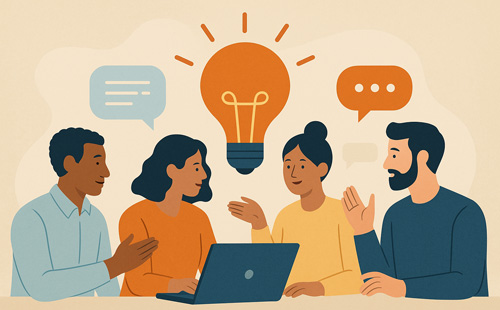Collaborative knowledge communication: From evidence to shared action
Why collaborative knowledge communication matters
Each year on 20 October, the global community observes World Evidence-Based Healthcare (EBHC) Day, a time to reflect on how evidence influences better health decisions. The 2025 theme, Collaborative Knowledge Communication, encourages us to think about how evidence ‘travels’ and how it is transformed into actions that save lives.
In our daily work at the GIMBE Foundation, we witness a paradox: never before has so much scientific evidence been produced, yet evidence alone is insufficient to bring about change. Without clear, inclusive and trustworthy communication, knowledge often remains confined to academic journals or policy reports, while misinformation spreads widely. For us, the challenge is not only generating evidence, but ensuring that it ‘travels’, reaching people, inspiring trust and ultimately driving collective action for health.
This is why the global EBHC community continuously experiments with new ways to bridge evidence and action, learning from both successes and failures.
When evidence fails to reach people
Evidence-based healthcare is founded on the idea that clinical and health policy choices should rely on the best available research . However, there are specific circumstances in which evidence fails to reach people:
- When evidence remains confined to expert circles. Traditional channels — such as scientific journals, conferences and technical reports — are crucial for professionals, but often inaccessible to citizens. They are written in scientific jargon which is inaccessible to the general public. Even international congresses, while vital for advancing professional knowledge, often struggle to make their outputs resonate beyond the expert community.
- When misinformation spreads faster than facts. Despite the surge of information available through social media and digital platforms, this unfortunately also brings a flood of misinformation and disinformation that erodes public trust in science. During the COVID-19 pandemic, dashboards and open data-sharing became valuable tools for transparency. However, this was also when false claims, conspiracy theories and politicised narratives circulated widely through social media, creating confusion.
- When evidence is politicised. The politicisation of evidence isn't a new phenomenon, but it has become more relevant recently. For example, efforts to undermine vaccine studies for political reasons reveal how fragile trust can be when evidence is used as propaganda instead of serving the public good.
These circumstances demonstrate that evidence does not automatically translate into action. Instead, communication must anticipate the risks of distortion and actively engage with communities to prevent evidence from being lost along the way.
This recognition leads us to the next question: how can we explore new inclusive ways of sharing knowledge so that evidence not only exists, but genuinely connects with society?
Exploring new ways of sharing knowledge
If evidence fails to reach people through traditional pathways, we must experiment with new ways of communication that are inclusive, engaging and responsive to context. Across the globe, such approaches are multiplying, often bridging the gap between science and everyday realities.

From institutional frameworks to storytelling. The World Health Organization (WHO) has created a Strategic Communications Framework for effective communications, emphasising key principles such as ‘Know the audience’, ‘Listen to the audience’, ‘Tailor the message’ and ‘Motivate the audience’. In addition, across the globe, new ways of sharing knowledge through collaboration are emerging, from podcasts, infographics and videos to more innovative formats like theatre, games or storytelling. These are practical tools meant to make guidance timely, clear and engaging rather than just abstract slogans.
From one-way to two-way communication. The WHO’s Communication for Health (C4H) initiative, tested in countries like Papua New Guinea, Malaysia and China, demonstrates how dialogue with communities can improve clarity, cultural relevance and trust. Similarly, citizen science projects such as The People’s Review, created by Cochrane Ireland and Evidence Synthesis Ireland, invite members of the public to shape systematic reviews, empowering individuals to become partners in evidence synthesis.
Learning from the Global South. Valuable innovations also come from low-resource settings. In Cameroon, the organisation, eBASE Africa, collaborated with health workers and caregivers to improve uptake of the Penta vaccine. By using simple communication tools — such as counselling guides, posters, SMS reminders and community dialogues — they built trust and increased vaccination rates. This example reminds us that effective communication is not only about advanced technologies, but about tailoring messages to local needs and involving people directly.
Technology as an enabler, not a solution. Artificial intelligence can support accessibility and translation and social media can amplify trusted voices, but tools alone are insufficient. Their value depends on how responsibly they are designed, governed and integrated into broader strategies of collaborative knowledge communication. We have covered this topic extensively in the blog for the World EBHC Day 2024 Campaign.
Together, these practices suggest that evidence travels further when it moves through channels that are participatory, culturally sensitive and transparent. They are not meant to be an exhaustive list, but rather a glimpse into the diverse and creative ways in which collaborative communication is emerging across the world. The challenge now is to understand what we can learn from these experiences and how they can inform broader strategies for making evidence work in practice.
What we can learn from promising practice
The examples above show that communication is most effective when it goes beyond transmission and becomes collaboration. What, then, can we learn from these promising practices?
Community engagement is central. Vaccination campaigns have repeatedly demonstrated that when evidence is combined with strong community participation and culturally tailored messages, the impact is both wider and longer lasting. This is as true in high-income countries as it is in countries such as Cameroon, where local health workers and community dialogue played a key role in increasing Penta vaccine coverage.
Networks amplify impact. International initiatives and networks create vital spaces where clinicians, researchers, policymakers and communities can exchange perspectives and adapt solutions to their own contexts. These platforms are not just professional milestones; they provide opportunities to rethink how evidence is translated into collective action. In this spirit, here at GIMBE Foundation we are committed to creating opportunities where evidence champions can meet and exchange perspectives. The EBHC International Conference is one such forum: not as a showcase, but as a living space for dialogue, collaboration and reflection. For us, this is less about organising an event and more about fostering a culture where evidence is openly discussed, challenged and made accessible across boundaries.
Learning from these experiences means recognising that no single model fits all. Each setting offers lessons —whether from a rural African community, an international network or a national foundation — that can inform broader strategies for connecting evidence with people. Yet, even with these promising practices, significant barriers remain: challenges that must be confronted if collaborative knowledge communication is to become a true driver of change.
Barriers we must overcome
Although progress has been made, significant barriers continue to limit the impact of collaborative knowledge communication.
When uncertainty is not well explained. Evidence is seldom clearcut. During the COVID-19 pandemic, inconsistent explanations of probabilities and risks left citizens confused and sceptical. Communicating uncertainty in ways that foster trust rather than diminish it remains one of the greatest challenges.
When people lack tools to navigate information. Health literacy is uneven across societies. In high-income settings, technical language often excludes non-specialists, while in low-resource contexts, barriers such as limited internet access or language diversity make critical appraisal even harder. In both cases, the result is the same: people struggle to distinguish reliable information from noise.
When communication is unidirectional. Too often, evidence is transmitted from experts to the public without listening in return. The Cameroonian experience with the Penta vaccine reminds us that dialogue — listening as much as informing — creates trust and shared responsibility. Without it, even the most robust evidence risks being ignored.
When coordination and transparency break down. During the pandemic, contradictory messages from experts and institutions generated confusion. These failures show that communication cannot be an afterthought; it must be coordinated, transparent and empathetic to avoid undermining public confidence.
Recognising these barriers is essential. They remind us that communication is not an accessory to evidence, but a core component of evidence-based healthcare itself — an ongoing process of building trust, understanding and collective responsibility.
Moving forward together
To bridge the gap between what we know and what we do, collaborative knowledge-sharing must become a fundamental aspect of evidence-based healthcare practice. This is not a secondary activity, but a core responsibility for institutions, professionals and communities alike.
Embedding communication within institutions. Health organisations, universities and policymakers must integrate communication as a structural component, not an add-on. Without this commitment, even the best evidence risks remaining unused.
Investing in health literacy and empowerment. Citizens need tools to critically and confidently navigate information. In this perspective, the project La salute tiene banco by GIMBE Foundation represents a concrete model of citizen empowerment: through schools, it fosters health literacy among younger generations and promotes collective responsibility for the future of the National Health Service.
Using technology responsibly. Artificial intelligence and digital platforms can enhance impact, but only if they follow ethical standards and promote inclusivity rather than division.
Supporting trusted advocates. Clinicians, patients and community leaders can act as credible messengers who connect evidence with people’s everyday lives. As shown during vaccination campaigns — from Europe to Cameroon — trusted voices can make the difference between confusion and confidence.
Moving forward together means recognising that evidence alone is not enough. What matters is how it is communicated, shared and lived. By treating communication as an integral part of evidence-based healthcare, we can ensure that knowledge does not stop at publication, but travels—reaching people, inspiring trust and driving collective action for better health.
Key take-home messages
1. Evidence alone is not enough — its impact depends on how well it is communicated, shared and understood.
2. Collaboration strengthens trust — communication must involve not only experts, but also communities, patients and citizens.
3. Health literacy is essential — empowering people to navigate and interpret information is as important as producing evidence itself.
4. Communication is integral to EBHC — it is not an add-on, but a core part of building trust and turning knowledge into action.
References
Cartabellotta A, Tilson JK. The ecosystem of evidence cannot thrive without efficiency of knowledge generation, synthesis and translation. J Clin Epidemiol. 2019;110:90-95
European Commission. Tackling coronavirus disinformation.
Evidence-Based Healthcare (EBHC) International Joint Conference.
Improving Penta Vaccine Uptake Through Clinical Communication in Cameroon.
La Salute Tiene Banco. GIMBE Foundation.
Reuters. Medical journal rejects Kennedy’s call for retraction of vaccine study.ink
The People’s Review (Cochrane Ireland & Evidence Synthesis Ireland).
World EBHC Day. Potential and challenges of AI and digital innovations (2024 Blog).
World Health Organization (WHO). Communication for Health (C4H) – Case studies.
World Health Organization (WHO). Communicating for health: strategic framework.
World Health Organization (WHO). Tactics to apply to make your communications understandable.
World Health Organization (WHO). Science in 5.
To link to this article - DOI: https://doi.org/10.70253/QMEO6257
Disclaimer
The views expressed in this World EBHC Day Blog, as well as any errors or omissions, are the sole responsibility of the author and do not represent the views of the World EBHC Day Steering Committee, Official Partners or Sponsors; nor does it imply endorsement by the aforementioned parties.
